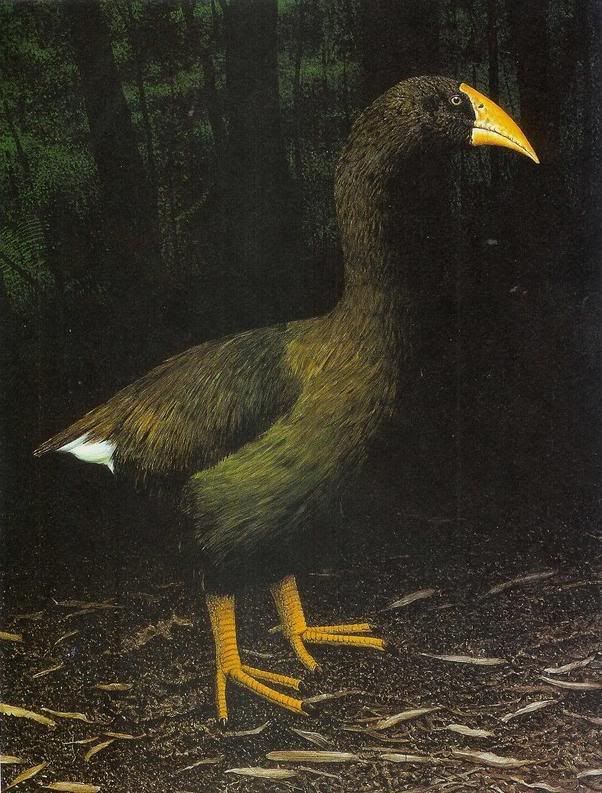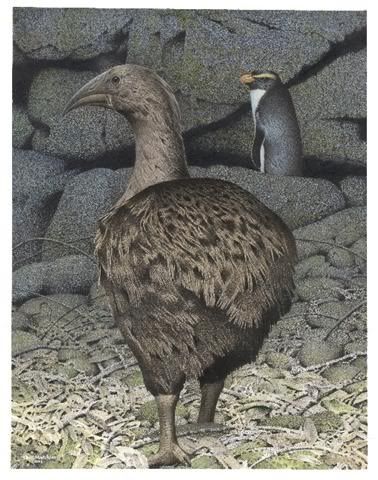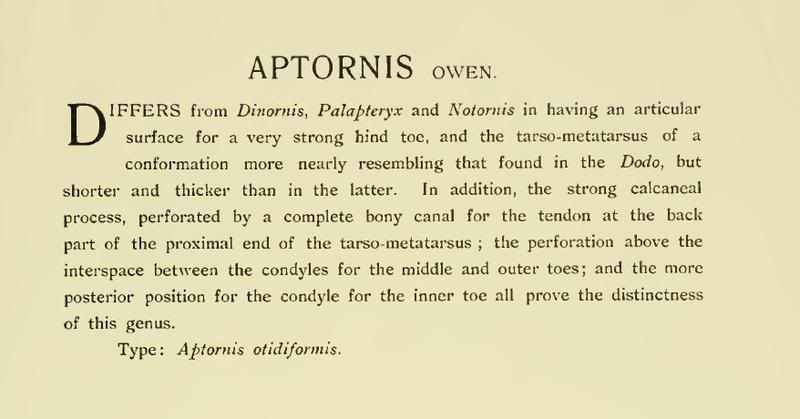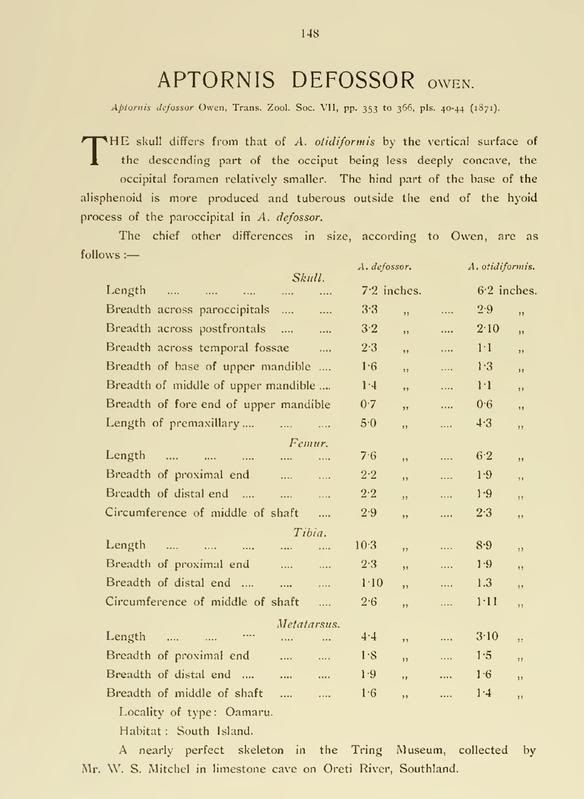|
|
Post by another specialist on Dec 31, 2006 13:32:51 GMT
two subspecies have been named Aptornis oditiformis defossor(South Is) & Aptornis oditiformis oditiformis (North Is) but the two forms are sometimes treated as separate species. |
|
|
|
Post by another specialist on Dec 31, 2006 13:33:43 GMT
Aptornis defossor Owen 1844 Holocene of South Island, New Zealand Primary materials: Complete skeleton Larger than A. otidiformes Erich Weber & Angelika Hesse, The systematic position of Aptornis, a flightless bird from New Zealand Courier Forschungsinstitut Senckenberg 181 (1995): 292-301 |
|
|
|
Post by another specialist on Dec 31, 2006 13:34:22 GMT
|
|
|
|
Post by another specialist on Dec 31, 2006 13:36:04 GMT
The Aptornithidae is an extinct bird family known only from New Zealand. They have traditionally been associated with the rails, in spite of their large size, roughly that of Great Bustard, Otis tarda. However, they have a distinctive jaw like structure which sets them apart from the rails. Affinities with the Kagus have also been postulated. In 1995, Weber & Hesse expressed their suspicion that the Galloanserae may be the sister group to the Aptornithidae, on the basis of cranial characteristics. Adzebill bones have been found at many sites in the North and South Islands, including Maori kitchen middens. A South Island subspecies, Aptornis oditiformis defosser, has been distinguished which was larger than the North Island form. The two forms are sometimes treated as different species. The skull is massive, with a thick walled brain case. The long down curved bill is stout and pointed with thick cutting edges. Small wing bones indicate that adzebills were flightless. They stood about 80 cm tall and may have weighed up to 12 kilograms. With its huge beak, immense neck muscles and strong feet, it seems as if it was superbly adapted for digging, but no one knows the reason for this adaptation. Did it smash open logs searching for grubs and insects, break into the burrows of seabirds and tuatara and eat them, or feed on roots and tubers? Brian Gill has suggested they probably ate berries, leaves of soft herbaceous plants, invertebrates such as insects and spiders, and small vertebrates such as lizards. There is some evidence that they preferred open habitats as opposed to dense forest. It fell victim to humans, dogs and rats, once the Maori reached New Zealand about 1000 years ago. www.nzbirds.com/Adzbill.html |
|
|
|
Post by another specialist on Dec 31, 2006 13:37:02 GMT
Hi ! Aptornis defossor, somewhat larger than the former:  Bye Alex |
|
|
|
Post by another specialist on Dec 31, 2006 13:38:19 GMT
Classification Kingdom: Animalia Phylum: Chordata Class: Aves Order: Gruiformes Family: Aptornithidae Genus: Aptornis Species Aptornis otidiformis Aptornis defossor The adzebills (genus Aptornis) were two closely related bird species, the North Island Adzebill (Aptornis otidiformis Owen 1844) and the South Island Adzebill (Aptornis defossor Owen 1871) of the extinct family Aptornithidae (Mantell 1848). The family was endemic to New Zealand, has been placed, by various studies of morphology and DNA, variously close to and far off from the Kagu of New Caledonia, as well as the trumpeters in the order Gruiformes. Its morphological closeness to the kagu may be the result of convergent evolution, although New Zealand's proximity to New Caledonia and shared biological affinities (the two islands are part of the same microcontinent) has led some researchers to suggest they share a common ancestor from Gondwana. In life the adzebills were massive gruiforms, the size of small moas (with which they were initially confused with on their discovery) with enormous downward pointed bill. They were flightless, having very reduced wings (smaller for their size than those of the dodo), and strong legs. The two species varied mostly in size, the North Island Adzebill being the smaller species. Their fossils have been found the drier areas of New Zealand, and only in the lowlands. Richard Owen, who described the two species, speculated that it was an omnivore, and analysis of its bones by stable isotope analysis has seemingly confirmed this. They are thought to have fed on large invertebrates, lizards, tuataras and even small birds. The adzebills were never as common as the moas, and subjected to the same hunting pressure as the moas and other large birds by the settling Polynesians, they went extinct before the arrival of European explorers. Their remains have been found in archeological sites across New Zealand. Sources: Wikipedia: en.wikipedia.org/wiki/Adzebillwww.teara.govt.nz/NewZealanders/MaoriNewZealanders/WhenWasNewZealandFirstSettled/7/ENZ-Resources/Standard/2/mi |
|
|
|
Post by another specialist on Dec 31, 2006 13:38:45 GMT
 New Zealand Extinct Birds Brian Gill and Paul Martinson |
|
|
|
Post by another specialist on Dec 31, 2006 13:39:37 GMT
South Island Adzebill. Aptornis defossor. From the series: Extinct Birds of New Zealand.  |
|
|
|
Post by another specialist on Jul 31, 2007 8:51:59 GMT
|
|
|
|
Post by another specialist on Jan 5, 2008 4:51:23 GMT
|
|
|
|
Post by another specialist on Jan 5, 2008 4:52:56 GMT
|
|
|
|
Post by another specialist on Jan 5, 2008 16:00:27 GMT
|
|
|
|
Post by another specialist on Jan 5, 2008 16:01:50 GMT
|
|
|
|
Post by another specialist on Jul 21, 2008 6:49:39 GMT
  Extinct birds : an attempt to unite in one volume a short account of those birds which have become extinct in historical times : that is, within the last six or seven hundred years : to which are added a few which still exist, but are on the verge of extinction (1907) |
|
|
|
Post by another specialist on Nov 26, 2008 7:40:05 GMT
|
|
|
|
Post by another specialist on Nov 26, 2008 7:41:12 GMT
|
|
|
|
Post by another specialist on Dec 29, 2008 10:21:24 GMT
|
|
|
|
Post by surroundx on May 7, 2015 8:58:47 GMT
Allentoft, M. E., Scofield, R. P., Oskam, C. L.,Hale, M. L., Holdaway, Richard N. and Bunce, M. (2011). A molecular characterization of a newly discovered megafaunal fossil site in North Canterbury, South Island, New Zealand. Journal of the Royal Society of New Zealand 42(4): 241-256. |
|
|
|
Post by surroundx on Jul 5, 2015 12:44:12 GMT
Andrews, C. W. (1896). Note on a nearly complete Skeleton of Aptornis defossor Owen. Geol. Mag. 3(6): 241-242. [ Abstract] |
|
|
|
Post by surroundx on Nov 14, 2016 12:22:06 GMT
|
|